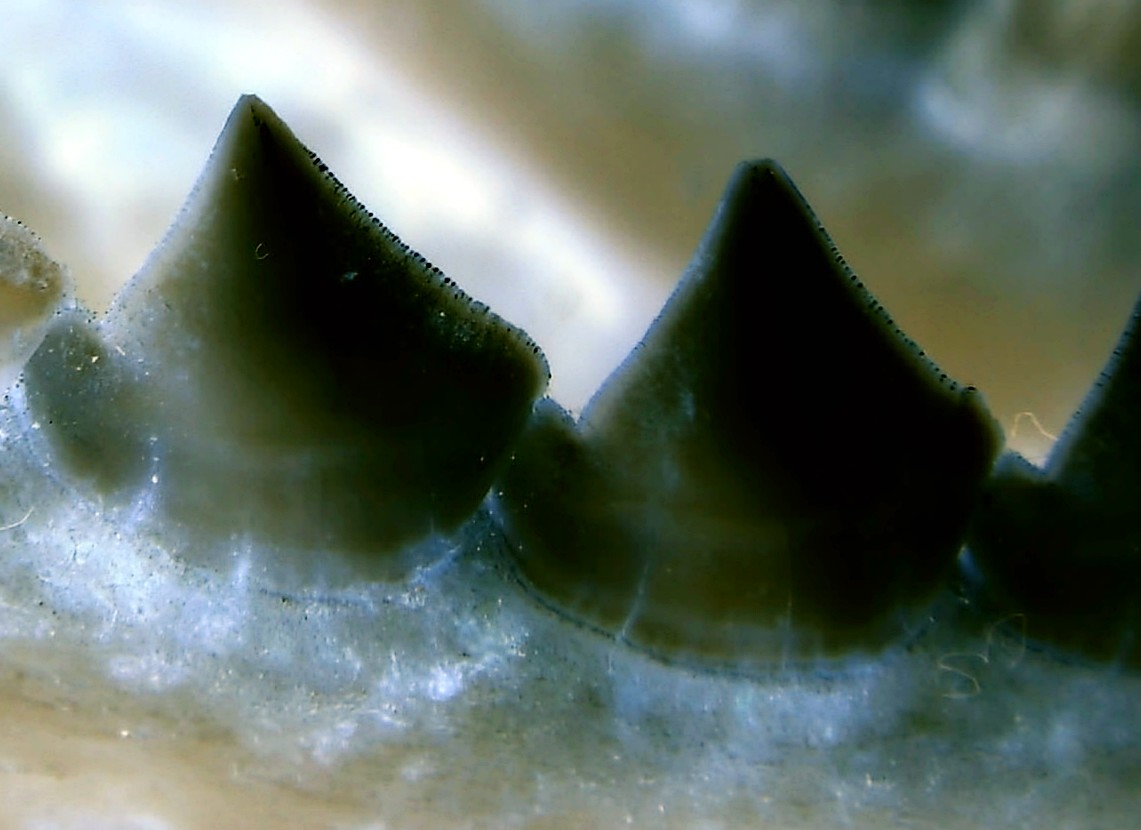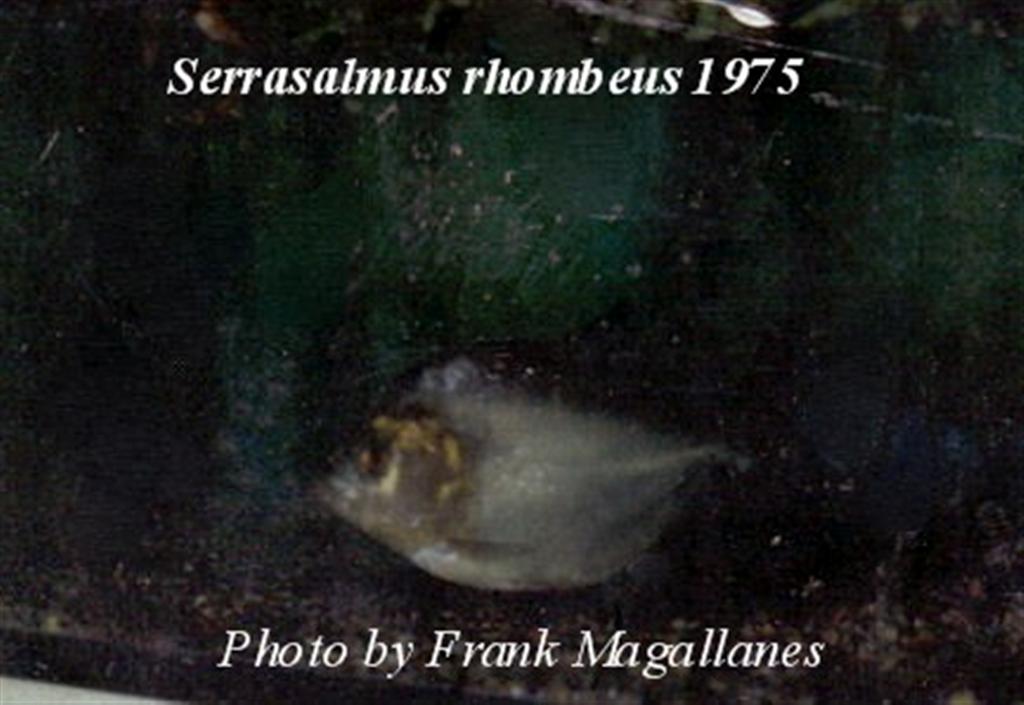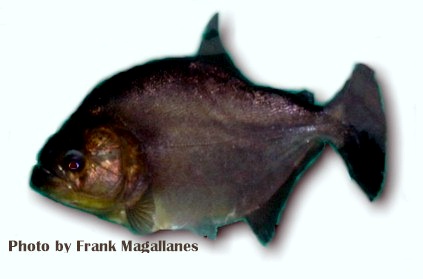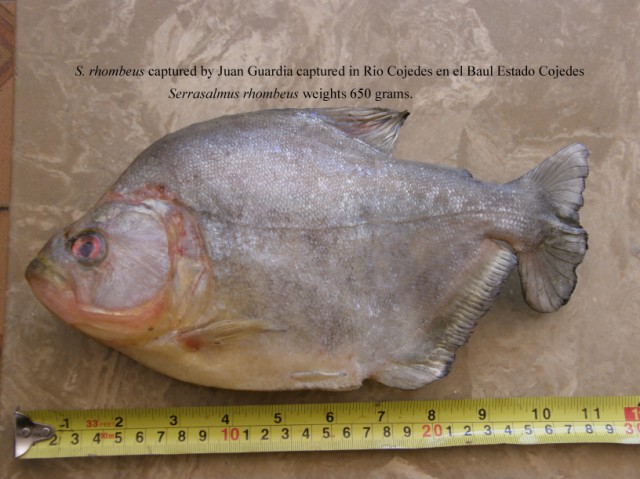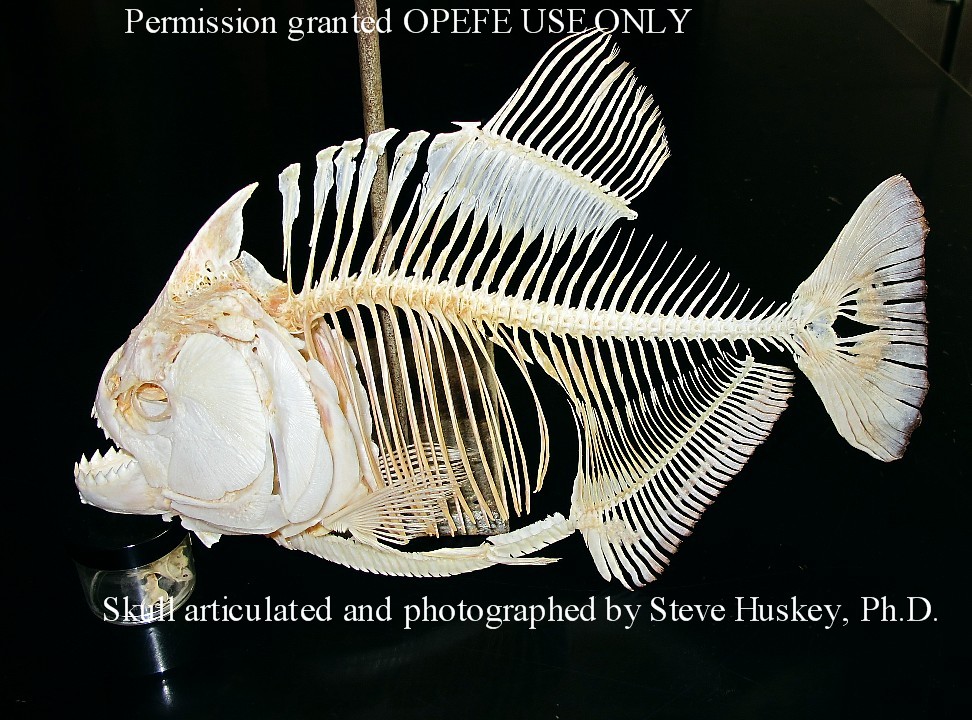Recently (June 28, 2011), I
got into a conversation with John Glennon (he is now retired from the Steinhardt
Aquarium). I asked him some questions regarding the above mentioned S.
rhombeus. John said the fish was on at Hot Fresh system of 32,000
gallons. According to John, Al Castro (biologist) originally kept the young S.
rhombeus in a 10 gallon aquarium. Which is how I saw the fish in
1971. Later the fish was moved to a 50 gallon aquarium where it remained
for the balance of its life. The circumstances surrounding its death was
unfortunate. It seems the night crew would sometimes turn out all the lights (to
conserve energy) and then shine a flashlight on the fish while making their
rounds. My experience with these fish leads me to believe the shining light
startled the S. rhombeus and that is why it jumped out. Seen it happen
time and time again when a flash from a camera was used.
I am often asked how long
does it take for this fish to grow to adult size. Unfortunately, no one
has ever recorded rhombeus growth rate in captivity. I have only
limited knowledge in postulating an answer to that question and only have a few
examples to offer. One thing to consider is, the above S. rhombeus did
grow to a large size (in my opinion) in a small container like the 50
gallon because water changes were done continuously. Thereby removing the
inhibiting growth hormone.
Another example is a rhombeus
I saw in Kent, Washington in 1975. The fish was 11 1/2 inches TL (the
reason I know this is because I bought the fish for $99!!!) SEE PHOTO ABOVE OR CLICK THIS LINK. The
fish was originally 7 inches TL in 1965 and kept in a 100 gallon aquarium
growing to its present size when I purchased it. In 1988 I purchased two more S.
rhombeus that were approximately 6 inches TL and they grew to about 9
inches when I again measured them again in 1993. They had lived in a 125 gallon
aquarium (separately in 2 different aquariums). The most recent example is a 3
inch TL S. rhombeus that was purchased in 1994 and today (August 17,
2000) the fish is only 9 inches TL. As you can see, the fish does not have a
very good captive growth rate. I doubt any of us could live long enough to see
it grow to its full size of 18-24 inches TL in the aquarium and is reported to
grow to 13 pounds!
BITE FORCE
Recently in May of 2011,
Steve Huskey, a PhD Functional Morphologist from Western Kentucky
University, Bowling Green, KY took the first recorded and documented bite force
of a large Serrasalmus rhombeus that weighed nearly 2 lbs. The fish was
caught in the Rio Xingu. The bite force was 70 psi. This means the size and body
mass of S. rhombeus far exceeds the bite force of the great white shark
in comparison!
RELEASED AS A NON-NATIVE
S. rhombeus has the
dubious distinction (along with Pygocentrus nattereri) of being the
only two species of piranha introduced in Unites States waters. In Florida
(1977), a breeding population was discovered at an abandoned amusement park
(originally misidentified as S. humeralis) in Dade County. They were
found in an over 1,000 gallon outdoor pond where they reproduced. Even
more interesting, the fish survived during Florida's winter. Preserved specimens
from the Miami area were deposited at University of Florida UF 87975, UF 97059 )
and were determined by W. L. Fink University of Michigan [personal
communication between Leo Nico Florida DNR and W. L. Fink, Voucher specimens:
Florida to be S. rhombeus and not S. humeralis.
STOLEN IMAGE
|

S. rhombeus
This image
which is property of Nature's images, Inc., (David M. Schleser) is one of the
most stolen images on the internet today. It's been used by disreputable web
sites and forums. If you see it being used, chances are, it was taken without
permission of Nature's Images photographer David M. Schleser. |
ATTACKS ON HUMANS
Attacks on humans by the
piranha Serrasalmus rhombeus in Suriname
Jan H. Mol
Center for Agricultural
Research in Suriname (CELOS) and Department of Biology, University of Suriname,
Suriname
ABSTRACT
Piranhas have a reputation of
being man-eating fishes, notwithstanding the absence of well-documented records
of piranha attacks on human beings. Three sites in Suriname where piranha
attacks on bathers have taken place are discussed. In two isolated villages on
the Wayombo River, most victims were children. In one village, 30 piranha
attacks occurred in a period of 12 years, bites were mostly on the feet, and
injuries were relatively harmless. In the second village, attacks occurred in a
period of 7 years, and injuries were more serious, including the loss of digits
and large and deep wounds in legs, arms and trunk. Two victims were attacked by
several piranhas simultaneously. At the third site, a recreation park on the
Suriname River, most attacks involved a single bite on the feet and victims were
able to walk back to the beach without being attacked by other piranhas. Piranha
attacks on humans did not result in deaths. The recovery of a toe phalange (Wayombo
River) and a piece of flesh including a nail (Suriname River) from the stomach
of two piranhas identified the fish responsible for the attacks as Serrasalmus
rhombeus. Attacks on humans by S. rhombeus were associated with high
age 0+ piranha densities in the dry season, high human prey densities, commotion
in the water by humans, and spillage of food, fish offal or blood in the water.
From Frank Magallanes
While the above ABSTRACT
suggests that these "attacks" are deliberate, one has to read beyond
the printed word and see that oftentimes, such attacks occur because of human
interference in the natural cycle of life. In other words, these attacks could
be the result of construction of dams to eliminate water flow, trapping
piranhas. Gutting and cleaning of fish along the banks or on bridges and tossing
the entrails makes a feeding regimen for piranhas. Lastly, the breeding cycle of
piranhas could also provoke attacks, since it is well established that
piranhas protect their eggs and young.
ABSTRACT
Cohen, Miles, A.; Beaumont,
William, R. C.; Thorp, Natalie, C. 1999
Environmental Biology of Fishes 54(1): 45-52
Adult black piranhas, Serrasalmus rhombeus, were radio-tracked using
purpose built equipment in the 2.6 km long oxbow lake Coco Cocha, south east
Peru during a five month period in the dry season of 1995. Fish were tagged
externally in front of the dorsal fin. S. rhombeus showed generally
localized movements in different sections of the lake with only one making use
of its whole length during the tracking period. S. rhombeus in the
shallower extreme sections of the lake were seen to make frequent trips into
flooded forest. Speed plots and perceived activity plots revealed cyclic
patterns of movement and activity synchronized with dawn. Those fish tracked at
night were active until after dark and sometimes throughout the night into the
early hours of the morning.
COMPLEX FORMS
VIEW VARIOUS GEOGRAPHICAL
FORMS OF RHOMBEUS COMPLEX. CLICK HERE.
Sometimes referred to by
hobbyists as a true black piranha, this name is nonsense since many
species of piranhas (for example; S. spilopleura) are referred to by
natives as Black Piranha in the locality from where they are found. The dark
color is very common among older piranhas and those in breeding condition. It is
quite possible this hobbyist referral to a true black piranha might
loosely refer to the old placement of S. niger to these species. However,
like the original S. niger description, this usage of the term; true
black piranha, is erroneous. S. rhombeus is an enigma to taxonomists to
this present day. Many species located in S. America were placed as other
species rather than S. rhombeus (such as; S. hollandi, S. gymnogenus,
S. aureus, etc.) based on juvenile forms or breeding forms (of S.
rhombeus) without taking into account the number of specimens needed to
better catalog them as an actual distinctive species. However, the
situation itself is much more complex than that, as is the species
identification, particularly among juvenile fish. While it is discussed below,
the rhombeus-complex group is still being looked at by competent
authorities today. The variety of body shapes, coloration, and size is
confusing. However, as stated below the consistency and trait of the species is
the eye color, always a rich lake (red) at maturity. Below, further discussed
(provided by a link) is the various geographical forms presented by George Fear.
Historical authors placed this species as a Pygocentrus because of the
adult form and lack of palatine teeth (worn off). In reviewing photographs from
hobbyists and samples sent to me, many of the fishes sold purported to be S.
rhombeus have largely been member of the compressus group. In rare
occasions, S. sanchezi has been sold as S. rhombeus because of the
similarity at juvenile sizes. So it is my suggestion, hobbyists need to review
the material here at OPEFE and compare their fishes to the photos provided.
The problem of rhombeus
nomenclature and description is a big one. There are several forms widely
distributed. The form living in the Guiana's are slender, while forms living in
the Orinoco, Amazonas and other South American rivers are deeper and very dark.
The only thing common is that they have a red eye.
Scientists believe that S. rhombeus is a complex of species. Both Dr.
W.L. Fink and Dr. Antonio Machado-Allison are still working with the Brazilian
species. According to Nakayama et al (unpubl) fishes from Catalão Lake
(a mixed water ecotone) which is formed by water from the Solimões River (white
waters) and the Negro River (acid and dark waters), this environment
caused some changes in chromomsomes in this species. This melting together
(or fusion) of the centromere (=the centromere consists of fibres and
holds together two to create a chromosome) by the eggs released by these species
may have been caused by interbreeding. In previous discussions with a field
researcher (1995) I discussed this topic of Serrasalmus species (in
particular S. spilopleura) interbreeding and new populations forming
after being cutoff from main rivers. At that time he thought it was unlikely.
This new DNA information is changing this perception.
There seem to be several
complex forms which vary in coloration and spotting. The distinctive red eye is
present on all of them after some reach 5 inches or larger in sizes, some could
be smaller in size. Their body color varies from silver to black with spotting
variable at all ages. The anal fin has a reddish tint, later during ontogeny
progressing to hyaline. A dark black margin on the anal fin is present on young
specimens, later fading in intensity on adults. I have seen S. rhombeus
belly colors also go through many ontogeny changes, from red, pink, yellow, gold
to white. With maturity, the belly color may become black or white, with the
upper body dark gray giving it a marbled appearance.
The white color often
attributed to the species S. rhombeus was based on a juvenile form,
however, water conditions can produce this effect on adults. The South American
Indians are the folks generally responsible for providing common names and
Piranha Branca (white piranha) is one of them. As Petry mentioned above it is
only natural the darker forms of rhombeus would be called Piranha negra
(black piranha) by natives. The common name itself has no scientific value and
the Indians use this name on quite a few number of dark piranhas without
discriminating the species it is. Presently, some species are being offered as
Araguaia or Xingu "rhombeus." I have been afforded the
opportunity to examine some of these species and most appear to be Serrasalmus
rhombeus. There might be some variation to spotting and elongation of the
body, but the majority seem to be this species. No systematist has yet to
publish otherwise.
IN THE AQUARIUM
Recommend keeping as solitary
species in home aquarium. Large specimens like the one above should be kept in
dimly lit aquariums. These larger one's inhabit deep waters where sunlight is
less likely to penetrate. They are river fish and require strong current. I
further suggest keeping them in a deep square tank than a long tank. Dimensions
should allow sufficient turn around for the fish so that it will avoid bent
tail syndrome, a feature seen on some fishes where the bottom or top of the
caudal fin is crooked. This sometimes occurs from a fish being kept in a
container that is to small for the fishes requirements. A power head is a must
for flow and to keep the fish healthy! Water temperature should range from
76-82F. Soft, slightly acid preferably between pH 6.8 to 7.4. In a topic further
below, I have included additional information on water chemistry reader's should
consider.
BREEDING S.
rhombeus
Only two or three species in
genus Serrasalmus have been bred in captivity. Only S. spilopleura
and S. maculatus have been bred in home aquariums. S. rhombeus
reproduced in captivity in large public aquariums ie; Duisburg Zoo, Germany in
1977 (Schulte, 1988) and one time in U.S. native waters at a zoo park in
Florida.
The reason why there haven't
been more successful breeding in the home aquarium is the species are extremely
aggressive with each other. Perhaps some pheromone is released in the water
causing the aggressiveness to subside, but no real research has been done to see
what the factors are to allow such spawning to take place. S. rhombeus
bred in captivity (public aquariums) require a huge volume of water.
At breeding or old age the
species becomes so dark that it is given the common name black piranha.
According to a piranha field researcher; "S. rhombeus from white water
looks washed out, almost completely white. This white appearance gives rhombeus
a strange appearance. Clear and black waters have fish with deeper color. The
darkest rhombeus ever seen were in the upper Uraricuera, which is clear water.
Nevertheless, the Rio Negro fish are quite dark as well. Somehow black water
creates great color contrast. Tannins are added in the home aquarium to enhance
the colors, also tannins also help facilitate breeding in most
piranhas."
The species is not sexually
dimorphic. Some insight on the male and female differences were made but
not conclusive for useful non-reproductive methods to determine sexuality during
rest.
So what would he average
hobbyist need to do in order to breed this species? Or is it even possible?
When one considers the size
of the aquariums that were successful, you are looking at having as a minimum
800g to over 1500g tanks. Or at the extreme, a large pool of water that is
environmentally controlled. Could it be possible to breed this species in a
smaller aquarium? As of this date, no hobbyist has reported such success. It
might be possible one day to use a smaller tank (500g), but not likely. But
until that day happens, let us stay within realism as much as possible. So, lets
go by the assumption you have a monster tank of 800g's or more (even 800g is
small but a good starting point). One of the key elements in such a tank would
be a water drip method and wet/dry system for filtration. Water chemistry for
this species is variable as its body morphology. So if you have one of the many
different body shapes and localities of S. rhombeus, it might be prudent
to research the water your fish comes from, if you know. Otherwise here are some
suggestions:
-
Rio Xingu: High
water; Temperature 80ºF pH 6.7 6.9
-
Rio Araguia: pH
5.8-7.5 (6.5), 4-20 dH (8), 72-82°F (22-28°C)
-
Rio Negro and Orinoco
rivers: pH: 4.5-7 (6.0); 2-8 dH (6); 75-82°F (24-28°C)
In attempting to breed this
species use the midline parameters of pH and temperature. The successful
breeding of S. rhombeus at the Duisburg Zoo (Aquarium Zoological Gardens)
Germany was accomplished in the evening hours 1900-2000 hrs(7pm to 8 pm). The
large (1200g) tank was densely planted with Cryptocoryne sp., Echinodorus,
Aponogeton, and Vallisneria. They appeared to defend the eggs. Water
temperature for the 1200g tank ranged from 20-25ºC (68-77ºF), extra soft (ion
exchanger), filtered over Ehfi substrate (coarse) and granulated lava material.
The eggs were layed in dense moss (1500 or more eggs) at a root of a tree on
that first occasion. After the fry developed and were a year old (they had been
removed from the parent tank), some were returned to the parents tank and swam
side by side peacefully with no problems. The adult fish spawned again in 1964
and 1965. The spawn was left in the tank and it was devoured. Once the group of
young fish (the one year olds) reached about 15 cm (6 inches) in length,
they turned on each other and reduced their number. The attacks were mostly from
the parent fish. It remains unclear how many were left alive.
GROWTH RATE
The Wharf Aquarium
(Old Fishermen's Wharf) in Monterey, California housed 2 large
specimen's of two species. The previous owner (and biologist) Nelson Bill
Hyler, confirmed the other species being red-throated S. sanchezi
after I provided a photograph to him and his own recollection of the fish having
a bright red throat and brilliant scales. The year was 1957, and my seeing those
fish for the first time impacted my life forever. It was also the trigger to
make piranha studies for me, a life-long project. I had the opportunity to speak
with Bill, circa 1997, his daughter Joanie operates the now known as The Wharf's General Store.
It was interesting to find
out this elderly gentleman could remember those piranhas so clear in his mind.
That information was extremely helpful to me and I credit Hyler and his
piranha display for giving me the idea to start OPEFE. I hope most of you will
get an opportunity to visit their store and the elegant City of Monterey. Later
I would visit the Steinhardt Aquarium in San Francisco, that same year and
seeing my first school of Pygocentrus nattereri, my journey studying
piranhas begins.....
WHY THE SLOW GROWTH RATE?
S. rhombeus are found
in fast water, mostly at eddies below rapids in rushing waters or in places with
faster flow if there aren't any rapids. Growth reduction in captivity is
likely associated to poor diet, thus feeding the whole fish and other vitamin
and protein rich food should take care of the problem. The other aspect is
the relative size of the tanks in which they are kept, and thus the quality of
the water. As stated, they are probably fairly sensitive to dissolved ions
and that could be a factor that reduces growth.
Always remember that they
live in very soft, nutrient poor waters to begin with, and thus are
physiologically adapted to those conditions. Any departure from that will
cost energy to regain osmotic and physiologic balance. Growth is largely
dependent on nutrition and environmental factors, thus captive fish may not grow
as large because of tank stress issues, but usually they do if a drip system is
used which would help replace water.
The record for S. rhombeus
is 7 lbs and a fraction, that is a big piranha. A 37.4 cm in length
(almost 14 3/4 in), may weigh 5 1/2 lbs. 7 lbs fish are close to 16
inch if not more.
STEALTH AND FOOD
The wash out in white color
for certain S. rhombeus probably works as a stealth mechanism, you don't
want to be black there, either as a prey or a predator. Many fish do this when
in different habitats. The species is a fin-eater, though it will eat whole fish
on occasion if the opportunity is there. Most bites reported are from careless
handling of the fish (see ATTACKS ON HUMANS) .
The largest wild caught
examples reported by fishermen average 50.0 cm or larger is common. Some
foods these fish eat include: 82.0% finfish, bony fish (juv./adults); 11.0%
terrestrial plants fruits/seeds; 7.0% zoobenthos benth. crust. crabs (juv./adults)
source: (Machado-Allison, Goulding). Juveniles inhabit areas that are
tranquil with abundant vegetation. Here they feed on micro crustaceans and
aquatic insects. Later, as adults, leave the protection of the vegetation to
live out their lives feeding principally on fins, parts of fish or whole in
deeper waters and in rapids.
PET STORES
Pet stores generally lump
piranhas into a color name if they are not sure what species it is. Some
situations, the wholesaler already has the fish marked as a certain species
under a scientific name without really being certain that it is that species.
The problem is further grossed out given the quality of information of the
piranha books published in the last 40 years which these dealers use for
guidance. The truth of the matter is the average pet store doesn't know what
piranha species they are selling and it is only recently that this situation has
improved by people visiting hobbyist piranha forum like Piranha Fury.
SCIENCE
Pygocentrus caribe
described by Valenciennes in Cuvier and Valenciennes (1850)(as a Serrasalmus),
apparently to provide binomial for the species description published by Humboldt
and Valenciennes (1821); See P. cariba.
Valenciennes apparently did not recognize the use of cariba in the figure
caption in that work as a proper christening of the species. Considered a
synonym of cariba herein; most authors, following Eigenmann (1915) have
considered it a synonym of S. rhombeus. (FINK, 1993).
Pygocentrus normanni,
described by Géry (1964) in Taddyella, based on a specimen of Serrasalmus
rhombeus from Surinam (Géry, 1972). Type not seen, but the figure from the
original description is clearly a Serrasalmus. (FINK, 1993). In this
species, the suborbital covers the opercle when the fish is still young (100 mm
or slightly more). Some of the species grow to a huge size (450 mm SL) at which
time they are almost black. S. rhombeus does
travel in more or less small groups of the same species. But this is not a
regular occurrence. The species is almost always solitary in contrast with the
true piranhas, preferring to hunt and travel alone. A humeral spot is present on
most geographical forms of S. rhombeus. However, this fades with the
dark ground color as the fish matures. This blemish may be very faint or
prominent depending on locality of collection.
Pygocentrus (Serrasalmus
niger): The reader can visit THIS PAGE
for more information about S. niger. The only known photograph of a live S.
niger known to me is the following from the Aquarium Journal, January 1955.
According to the cover photograph caption "The first specimen of Black
Piranha Serrasalmus niger Schomburgk, ever exhibited alive in the U.S.A.
It is the 11 inches long, and is now in the preserved fishes collection of the
Natural History Museum, Stanford University, No. SU 19417."
DnA
Updated information
(Numerical updates, highest number is current status). Please use the cited
references below to read the entire article:
2. Recent studies on
Amazonian Serrasalmus species have revealed karyotypic divergence between
and within populations of S. spilopleura and Serrasalmus rhombeus
(Nakayama et al., 2000, 2001, 2002; Centofante et al., 2002).
Nakayama et al. (2001) has suggested that S. rhombeus cryptic
species may exist based on the two cytotypes (2n = 58 and 2n = 60) found at Lake
Catalão located near the confluence of the Negro and Solimões rivers in the
Brazilian state of Amazonas. In addition to being identified by their karyotypes
(Nakayama et al., op. cit.) fish belonging to the S. rhombeus
complex are also moderately distinguishable by parasite analysis (Van Every and
Kritsky, 1992) but not by their 16S mitochondrial DNA (Ortí et al.,
1996) but as yet there have been no isoenzyme studies on this complex. The new S.
rhombeus cytotype reported here for the first time, 2n = 60 B
(44M-SM+4ST+12A) revealed monomorphism for the presumably fixed allele Est-D33,
and was detected in all four S. rhombeus specimens examined, although
this allele can only be definitively reported as fixed following the screening
of the Est-D3 locus in a larger population of the S. rhombeus 2n =
60 cytotype. Gradual frequency differences in the A*125 and B*210
alleles at two GPI loci detected in S. spilopleura caught between
the upper Paraná River (cytotype 'a') and the lower Paraná River (cytotype 'b'
and cytotype 'c') led Cestari (1996) to suggest that there may be interbreeding
between fish from these two sites, supporting the hypothesis of a hybrid origin
for the 'c' cytotype. However, our esterase-D and chromosome data do not support
the existence of different S. rhombeus piranha species in Lake Catalão
and there was no indication of hybridization among the S. rhombeus
cytotypes examined. Thus once cytotype-specific fixed alleles are detected in
any S. rhombeus isoenzyme patterns different taxonomic units with species
status will have to be formally recognized. (Aylton Saturnino Teixeira et al.,)
Karotype
and Nucleolar Organizer regions in Serrasalmus rhombeus (Serrasalminae) from
Caicara Del Orinoco, Venezuela.
M. Nirchio, A. Granado, E.
Ron, and J. E. Perez.
HISTORICAL
SCIENTIFIC NAMES
-
Salmo rhombeus
Linnaeus, 1766. Syst. Nat. ed. xxii, i:514.
-
Serrasalmus rhombeus
Lacepede, 1803, Hist. Nat. Poiss, 5:283-234.
-
Serrasalmus (Taddyella)
normani (Géry, 1964, Vie et Milieu, 14(3): 609-615, Fig. 4.
-
Pygocentrus pyraya
Epithet misspelled (not from Cuvier) Popta, 1914.
-
Pygocentrus
nigricans (not from Spix) Müller and Troschel, 1844.
-
Pygocentrus
niger (not from Schomburgk or from Müller
and Troschel) Valenciennes, 1849).
-
Serrasalmus boekeri Ahl,
E.,Sitzungsberichte der Gesellschaft Naturforschender Freunde zu Berlin,
3/1/31, Diagnosen einiger neuer südamerikanischer Süßwasserfische., Ahl, E.
. 1931 Sitzungsber. Ges. Naturf. Freunde Berlin. 1930(Oct-Dec):405-409.
DISTRIBUTION
Amazonas Basin, Orinoco
Basin, North and Eastern Guiana Shield rivers, Northeastern Brazilian coastal
rivers. Occurs in the rapids but is also captured in deep zones of main rivers.
Sometimes found with S. manueli.
Contributors and Advisors
-
Petry, Paulo
-
Hyler, Joanie
-
Hyler, Bill
REFERENCES
-
Aylton
Saturnino Teixeira; Celeste Mutuko Nakayama; Jorge Ivan Rebelo Porto; Eliana
Feldberg, (2006) Esterase-D and chromosome patterns in Central Amazon piranha
(Serrasalmus rhombeus Linnaeus, 1766) from Lake Catalão, Genet. Mol.
Biol. v.29 n.3 São Paulo.
-
Allendorf FW
and Utter FM (1979) Population genetics. In: Hoar WS, Randall DJ and Brett JR
(eds) Fish Physiology, v. 8. Academic Press, New York, pp 407-454.
-
Alonso SK
and Alfenas AC (1998) Isoenzimas na taxonomia e na genética de
fitonematóides. In: Alfenas AC (ed) Eletroforese de Isoenzimas e Proteínas
Afins. Editora da Universidade Federal de Viçosa, Viçosa, pp 525-539.
-
Anti AB
(2000) Caracterização de germoplasma de soja e de feijão através de
eletroforese de isoenzimas da semente. Bragantia 59:139-142
-
Norman, J.R.
The South American Characid Fishes of the Subfamily Serrasalmoninae, with a
revision of the Genus Serrasalmus Lacepède, 1929
-
Schomburgk,
Robert H. Fishes of British Guiana 2 Vols. In: The Naturalist's Library,
edited by Sr. Wm. Jardine, vols. 30 and 31, London, 1843.
-
Eigenmann,
Carl H., The Serrasalminae and Mylinae, In: Annals of the Carnegie Museum,
vol. 9, nos. 3 and 4, Pittsburg, Pa.
-
Machado-Allison,
Antonio and Fink, William., Los Peces Caribes de Venezuela, Diagnosis, Claves,
Aspectos Ecologicos Y Evolutivos.
-
Schulte,
Wolfgang., Piranhas in the Aquarium, TFH Publications, NJ 1988 pg. 90-94.
-
Géry, J.
1964 Contributions a l'étude des poissons characoïdes - 27: systématique et
évolution de quelques piranhas («Serrasalmus»).. Recueil d'observations de
zoologie...dans l'ocean AVie Milieu (Ser. C) Biol. Terr. 14(3):597-617. Name
on fig.4 (p.611); description on p.612.
-
Fink, W.L.
1993 Revision of the piranha genus «Pygocentrus» (Teleostei,
Characiformes). Copeia 1993(3):665-687
-
Dr. Arthur Topilow, 30 inch TL S. rhombeus, Jumbo Fishes For The
Large Aquarium, TFH Publications, Inc. Is it a hoax?
USE
YOUR BACKSPACE TO RETURN OR CLICK HERE TO RETURN SERRASALMUS LIST
RETURN TO RESEARCH CLICK THIS LINK
The OPEFE web site and its
contents; is disclaimed for purposes of Zoological Nomenclature in accordance
with the International Code of Zoological Nomenclature, Fourth Edition, Article
8.3 and 8.4. No new names or nomenclature changes are available from statements
at this web site.
Copyright© 1994-2012 Oregon
Piranha Exotic Fish Exhibit (The OPEFE fish exhibit is permanently CLOSED as of
2000) Sutherlin, Oregon. Information posted on this web site is archival data on
fish scientific classifications and other information. DISCLAIMER: The
copyrighted material may not be used for any purpose other than private study,
scholarship or research. Cited information requires credit and this link
www.opefe.com. All rights reserved. All images shown (unless otherwise
noted) is property of OPEFE.

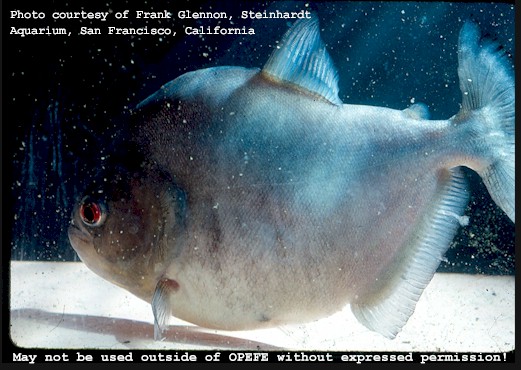 I
saw my first live S. rhombeus in 1957 and again in 1971. I am grateful to
Frank Glennon of the Steinhardt Aquarium San Francisco, California for informing
OPEFE that the oldest known (to me) piranha in captivity is *still alive (See
image at left of the actual fish). I personally saw this beast in September of
1971 when it was only 6 inches TL (= total length). After 28 years in captivity
this fish was only eleven inches TL (March, 1999) when it died. It was reported
to me by a hobbyist the S. rhombeus discussed above is no longer alive
(Sunday, August 6, 2000). It was thought the fish jumped out of the aquarium or
died some other way. Reportedly, the fish died sometime in the latter half of
1999. What a sad end to fish that lived for over 28 years.
I
saw my first live S. rhombeus in 1957 and again in 1971. I am grateful to
Frank Glennon of the Steinhardt Aquarium San Francisco, California for informing
OPEFE that the oldest known (to me) piranha in captivity is *still alive (See
image at left of the actual fish). I personally saw this beast in September of
1971 when it was only 6 inches TL (= total length). After 28 years in captivity
this fish was only eleven inches TL (March, 1999) when it died. It was reported
to me by a hobbyist the S. rhombeus discussed above is no longer alive
(Sunday, August 6, 2000). It was thought the fish jumped out of the aquarium or
died some other way. Reportedly, the fish died sometime in the latter half of
1999. What a sad end to fish that lived for over 28 years.
